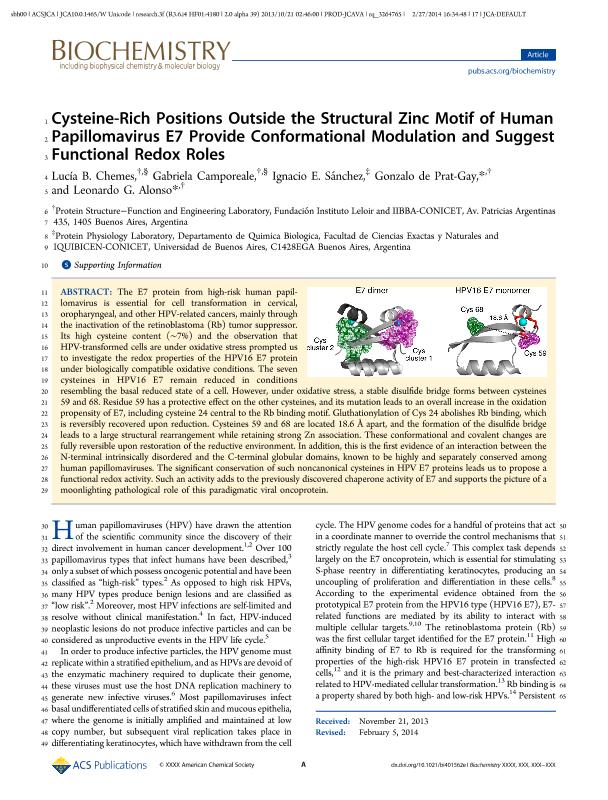Artículo
Cysteine-rich positions outside the structural zinc motif of human papillomavirus E7 provide conformational modulation and suggest functional redox roles
Chemes, Lucia Beatriz ; Camporeale, Gabriela
; Camporeale, Gabriela ; Sánchez Miguel, Ignacio Enrique
; Sánchez Miguel, Ignacio Enrique ; de Prat Gay, Gonzalo
; de Prat Gay, Gonzalo ; Alonso, Leonardo Gabriel
; Alonso, Leonardo Gabriel
 ; Camporeale, Gabriela
; Camporeale, Gabriela ; Sánchez Miguel, Ignacio Enrique
; Sánchez Miguel, Ignacio Enrique ; de Prat Gay, Gonzalo
; de Prat Gay, Gonzalo ; Alonso, Leonardo Gabriel
; Alonso, Leonardo Gabriel
Fecha de publicación:
02/2014
Editorial:
American Chemical Society
Revista:
Biochemistry
ISSN:
0006-2960
Idioma:
Inglés
Tipo de recurso:
Artículo publicado
Clasificación temática:
Resumen
The E7 protein from high-risk human papillomavirus is essential for cell transformation in cervical, oropharyngeal, and other HPV-related cancers, mainly through the inactivation of the retinoblastoma (Rb) tumor suppressor. Its high cysteine content (~7%) and the observation that HPV-transformed cells are under oxidative stress prompted us to investigate the redox properties of the HPV16 E7 protein under biologically compatible oxidative conditions. The seven cysteines in HPV16 E7 remain reduced in conditions resembling the basal reduced state of a cell. However, under oxidative stress, a stable disulfide bridge forms between cysteines 59 and 68. Residue 59 has a protective effect on the other cysteines, and its mutation leads to an overall increase in the oxidation propensity of E7, including cysteine 24 central to the Rb binding motif. Gluthationylation of Cys 24 abolishes Rb binding, which is reversibly recovered upon reduction. Cysteines 59 and 68 are located 18.6 Å apart, and the formation of the disulfide bridge leads to a large structural rearrangement while retaining strong Zn association. These conformational and covalent changes are fully reversible upon restoration of the reductive environment. In addition, this is the first evidence of an interaction between the N-terminal intrinsically disordered and the C-terminal globular domains, known to be highly and separately conserved among human papillomaviruses. The significant conservation of such noncanonical cysteines in HPV E7 proteins leads us to propose a functional redox activity. Such an activity adds to the previously discovered chaperone activity of E7 and supports the picture of a moonlighting pathological role of this paradigmatic viral oncoprotein.
Palabras clave:
Cysteine
,
Redox
,
Papillomavirus
,
Zinc Binding
Archivos asociados
Licencia
Identificadores
Colecciones
Articulos(IIBBA)
Articulos de INST.DE INVEST.BIOQUIMICAS DE BS.AS(I)
Articulos de INST.DE INVEST.BIOQUIMICAS DE BS.AS(I)
Articulos(IQUIBICEN)
Articulos de INSTITUTO DE QUIMICA BIOLOGICA DE LA FACULTAD DE CS. EXACTAS Y NATURALES
Articulos de INSTITUTO DE QUIMICA BIOLOGICA DE LA FACULTAD DE CS. EXACTAS Y NATURALES
Citación
Chemes, Lucia Beatriz; Camporeale, Gabriela; Sánchez Miguel, Ignacio Enrique; de Prat Gay, Gonzalo; Alonso, Leonardo Gabriel; Cysteine-rich positions outside the structural zinc motif of human papillomavirus E7 provide conformational modulation and suggest functional redox roles; American Chemical Society; Biochemistry; 53; 10; 2-2014; 1680-1696
Compartir
Altmétricas



